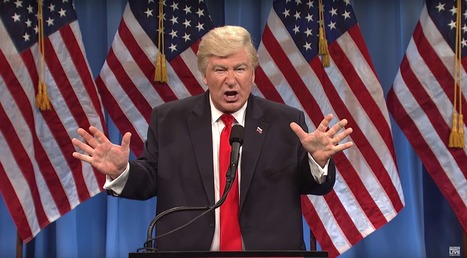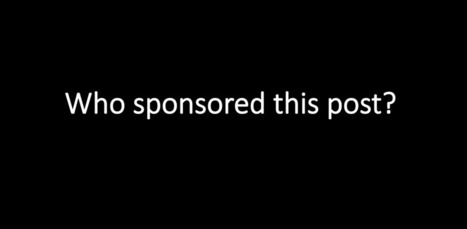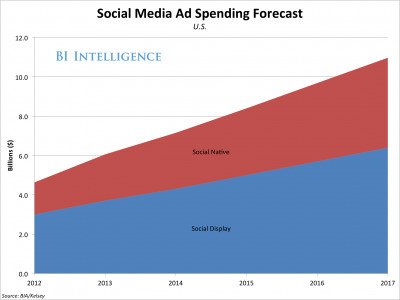 Your new post is loading...
 Your new post is loading...
Alec Baldwin has been killing it as President Donald Trump on Saturday Night Live.
iPhone ads are about to get a lot funnier.
Apple is reportedly planning to inject some much-needed humor into a few of its upcoming commercials after striking a deal with NBC that will see the team behind Saturday Night Live write a few ads for the iPhone-maker.
The partnership between Apple and NBC will result in a series of commercials slated to appear during Saturday Night Live in a couple of weeks, according to Variety. SNL also scored a deal with Verizon that will result in two ad spots being shown on April 8 and April 15.
Like most news publications, the 14 organizations that participated in a recent study of native advertising label the content to distinguish it from their independent editorial content. They said they were well aware of the need to maintain audience trust in the crowded news and information market.
However, in general, the use of the same storytelling conventions and formats as news in sponsored content has prompted user confusion and drawn the attention of the Federal Trade Commission.
The 14 publications that participated in "The Rise of Sponsored Content in Digital News Publications," a study I produced for the Tow-Knight Center for Entrepreneurial Journalism at City University of New York, maintained that native ads done well aren’t necessarily deceptive or even unwelcome. The key they said, is to provide engaging content that is relevant to the audience and to generally avoid making direct sales pitches.
“I don’t think anybody objects to native advertising. People just object to bad advertising,” said Sebastian Tomich, Senior Vice President Advertising & Innovation at The New York Times. “It comes down to quality, user experience and quality.”...
Therein lies the problem: native advertising is more effective because it masquerades as actual content. But it’s illegal to pass advertising messages off as editorial content. The Advertising Standards Authority in the United Kingdom, for instance, banned a native YouTube ad sponsored by Oreo that featured two well known video bloggers because the agency felt it was not clearly identified as marketing communication.
Stateside, the Federal Trade Commission (“FTC”) has long waged war on false advertising—marketing or advertising communications that tend to mislead consumers. Recently, the FTC issued an “enforcement policy statement on deceptively formatted advertisements” giving advertisers and publishers alike a heads up: deceptive native ads will not be tolerated.
So how can your brand capitalize on native advertising without breaking the law? The FTC offers some insight in their guide, “Native Advertising: A Guide for Businesses.”...
At a time when good-paying freelance assignments are harder to come by, many journalists are heeding the call of native advertising, where the pay is decent and the work is steady. But there’s a cost. Many worry about the impact on their credibility as a journalist. Some are even finding they aren’t so welcome back in newsrooms once they work for the business side.
In the latest in Digiday’s “Confessions” series, we talked to a veteran freelance writer who has written for top women’s magazines and other national publications about the dark side of native. In this case, the journalist was working for a publisher’s content studio, which assigned stories a given client wanted written....
It seems like everyone has something controversial to say about sponsored content these days, from John Oliver on HBO to even us here at Contently.Much of that controversy centers around two key questions: Is brand-backed content on publisher sites labeled well enough? And is it eroding the publishers’ editorial independence and reputation?
Now, a Google engineer has taken on this transparency and labeling challenge with a browser plug-in for Chrome and Firefox called AdDetector, that adds another layer of labeling to sponsored posts. It’s drumming up a fair amount of buzz in the media world already....
On Sunday's Last Week Tonight With Jon Oliver, the network took their commentary on the separation of business and journalism up a notch and completely annihilated sponsored content. Needless to say, it was hilarious.
...Oliver started off his rant by noting that he was lucky to work for advertisement-free HBO, where he is free to say that “Old Navy makes you look like a tacky murderer.” After that, Oliver delivered 11 full minutes of pinpoint jokes about native ads. Few escaped the fire, with The New York Times‘ Meredith Levien, TIME Inc. CEO Joseph Ripp, and BuzzFeed co-founder Jonah Peretti on the receiving end of Last Week Tonight’s hottest burns....
From rich media to programmatic buying, we've got you covered.
Anyone starting a career in the advertising industry is presented with a digital advertising ecosystem with numerous intricacies and a befuddling number of buzzwords and acronyms.
What is the difference between native advertising and sponsored content? Or programmatic buying and real-time bidding? We want to put you on the path of advertising jargon mindfulness. Below, you'll find easy-to-read descriptions of some of the industry's hottest buzzwords, the phrases you've heard a bunch of times but maybe don't quite totally understand....
Go big or go home, right? Brands everywhere are going over the top to impress consumers and grab their attention. To do this, they’re coupling pranks with video advertising strategies to create compelling content that goes viral. While some marvel at the creativity, others argue that prankvertising goes too far. Regardless, the power of the latest trend in video advertising is undeniable. Here are some of our favorite prankvertisements.
How can publishers and advertisers survive in today's economy?
Only 6% of the 18-24 population read newspapers; the majority of newspaper readers in this country are in their fifties and sixties. Audiences for CNN, MSNBC, and Fox News pull in viewers with a median age of 60 or above, according to media research company Nielsen.Websites like Yahoo News and Huffington Post pull more traffic than CNN.com or The New York Times website. In two years, Buzzfeed (designed to stimulate social media with listicles: "25 Crazy Things...") has nearly tripled its monthly unique visitors, from 4.3 million to 19.3 million.
Traditional news has lost young people, the gold standard for advertisers....
Facebook, Twitter, Pinterest are all moving to native ads. The native-social rush is on.
BIA/Kelsey estimates that social ad spend will reach over $10 billion by 2017 and that up to 40% or more of those outlays will go to native ads. In the social context, we define native ads as ads that are seamlessly integrated into a user's feed and are nearly indistinguishable from organic content.
...On Facebook, native ads in the News Feed generate 49-times higher click-through rates and a 54% lower cost-per-click than traditional placements in the right-rail sidebar. LinkedIn is making major investments in its native strategy and Pinterest is piloting native ads on its platform.
According to Jan Rezab, CEO of Socialbakers, a social media analytics company that works with Fortune 100 brands, "In the future, all advertising on social media will be native in-stream ads. The right rail and banners will disappear altogether."...
While Twitter and texting appear to be reducing our communications skills to the level of a grunt, there has been a spate of TV spots in which the power of the long copy has been applauded by the industry, consumers and award juries alike.
Spots like the multi-lauded “Born of Fire” spot for Chrysler by Wieden +Kennedy, which gave Detroit, a city considered lost for decades now, something to be proud of. These words didn’t just sell a car, they uplifted an entire city.I remember watching this ad in the jury room in Cannes and feeling the hairs on my arm stand up. It was also interesting that the power of the words were not lost on the international jury. Jokes and special effects used to be the way to win at Cannes. Maybe not so anymore....
Here it is. The 100+ Best Slides From Cannes Lions 2012. Now if you’ve been to the Cannes Lions International Festival of Creativity, you’ll know the vast array of amazing content on offer, but perhaps the only challenge you’ll have all week, is choosing what sessions to attend.
So, as he always does, my good friend Jesse Desjardins (@JesseDee) has curated the 100+ Best Slides from the entire Cannes Lions Festival, meaning if you missed a session, couldn’t remember that kick-ass slide or spent your whole Cannes Lions trip partying on the beach, you can utilise some of this to convince your boss you might have actually went to the sessions!...
As absurd as it may sound, chatting with ads could become commonplace as speech-communication with computers continues to evolve. Just looking at ads is bad enough, so who would want to talk to them? While many people would likely answer "no one," voice-recognition software maker Nuance says the opposite is true. What Is A Voice Ad? Wanting in on the booming mobile ad market, Nuance developed a way for people to chat with ads much as they do with Siri on the iPhone. Called Voice Ads, the technology works off the Internet connection of any iOS or Android mobile device.... Hey. You. Get offa my phone!
|
Native Insider: Part of the challenge with "native" is that each organization has a different understanding of what it is. For the purposes of the research, what is your definition of native advertising?
Wu: In our study, we defined native advertising as sponsored content, which features content that is similar and consistent with publishers’ content and is often consumed by readers like non-sponsored content. I agree that there are also other types of native advertising, such as sponsored social media posts or sponsored hyperlinks. We focused on sponsored content because it is widely adopted by many news organizations, including very reputable ones like The New York Times.
Native Insider: Your research found that when content was identified as native advertising, readers expressed a lower opinion of the media outlet it was published in. However, the reputation of the company being promoted was not affected. Can you elaborate on this finding?
Wu: I think this was one of the most interesting findings in our study. We originally expected that both companies and media outlets would be negatively influenced. However, the media outlet was the only source that was affected. On one hand, this indicates that readers are not surprised by the sponsored content from a company, since similar covert marketing techniques have been utilized before, such as video news releases....
The underlying reason? Today’s shoppers are skeptic of pure play tactics. They see value in connecting and acquiring rather than reliance on a brand’s library of products. As a result, they are looking for shopping destinations or inspirational sites.
Perhaps that’s why brands are agog over social commerce.
For those unaware, it is the concept of utilizing social networks to increase sales transactions. Actionable marketing expert Heidi Cohen defines it as the maturation and evolution of social media meets shopping....
Want to know what the future of content marketing looks like? Just ask Google – or more accurately, check out its leaked patents for a new type of advertisement. It’s emblematic of what brands should be doing to stay top-of-mind among prospects and ultimately lead to higher engagement and conversion rates.
The new advertising product is basically a content-rich splash ad that follows users from one page to another. Rather than a banner, which just takes customers to a landing page and interrupts the flow of their navigation, these “morphing” ads will feature menus for readers to click on and manipulate and multiple forms of content, including pictures, video and text. More importantly, the ads will follow people from one site to another, allowing them to continue reading no matter what page they’ve loaded....
Programmatic advertising may be the sexy new buzz phrase, but more automation can lead to more clutter. When it comes to paid media on the web, the best way forward is to have fewer ads.
Online advertising has grown exponentially since its foundation in the 90s. Now, online ad sales make up the majority of the industry, and savvy companies are directing the lion’s share of their budgets at the digital space.
Advertising through social media is nothing new, but so far, brands have been playing it safe, using many of the same methods that have already been successful in the past – combining banner- and text-link-style ads in news feeds and sidebars. But the possibilities of social advertising have yet to be fully explored.
The real power comes not from the reach of a company’s network, but from getting that company’s customers to do the outreach FOR them.
Social media is changing the way people view and interact with content online. While the idea of a website “page” has been a vital component in the way people understand the web, the use of feed-based content in Facebook, Twitter and Instagram has changed the concept of what a website IS. ....
Ask any lifestyle magazine publisher how they’re making up for declining print revenue, and chances are they’ll mention e-commerce. But while countless publishers are struggling to drive dollars via online shopping, there’s a growing number of e-commerce companies moving in the opposite direction.
In recent months, customers of online-only retailers like Rent the Runway, JackThreads and Birchbox have received catalogs—yes, those old-school, printed booklets—in their mailboxes, while flash sale site One Kings Lane has been sending out “magalogs” combining decorating tips with photographs of rooms populated by the site’s ever-changing inventory....
The End of Advertising as We Know It--and What to Do Now | Fast Company
...Kodak filed for bankruptcy while Instagram was bought by Facebook for $1 billion. Airbnb is now filling more nights than Hilton Hotels. Nike+ Kinect Training [created by AKQA] is now "as good as a real trainer, costs less than a one hour’s lesson, and it’s 24/7 at home," as Chris Anderson put it.
The reality is this: Business ideas from the least expected players and angles will disrupt your brand faster than advertising can save it. A couple of years after the world’s biggest advertising award show ditched the word advertising, we’ve reached an inflection point: Advertising as we know it has come to an end.
Now what? Here are a few principles that can guide the shift from the Old World Order to the New World Order....
Read more: http://www.fastcocreate.com/1683292/the-end-of-advertising-as-we-know-it-and-what-to-do-now
How news organisations are building commercial teams of former journalists who create paid-for content on behalf of brands...
The Huffington Post, in conjunction with parent company AOL, last month published a report which proposed that native advertising is "sponsored content, which is relevant to the consumer experience, which is not interruptive, and which looks and feels similar to its editorial environment".
Perhaps the easiest way to understand it is by looking at a couple of examples, such as the Guardian's 'what to wear on a date' video, sponsored by John Lewis, with clothes featured in the video from the department store, and BuzzFeed's '20 coolest hybrid animals', created for hybrid car Toyota Prius....
The public relations industry is known for a lot of things: media relations, press conferences, event management, crisis communications, and, more recently, social media strategy and community management.
But there’s one thing that many communicators haven’t been particularly well-known for: creativity. At best, PR has been put in a box to amplify creative ideas developed by others. At worst, we’ve been accused of “spinning” stories or doing “stunts” to make a splash.
That’s changing. Over the last 18 months or so, branding, advertising and digital agencies’ dominance over creative campaigns has started to wane. Clients are increasingly turning to PR agencies to come up with the “big idea,” as the discipline is now in a good spot to call the shots on creative development. Here’s why.
Piggybacking onto major news events can give brands a shot at instant relevance. Or immediate embarrassment.Last week, a German lingerie company circulated some racy but sub-par ads that attempted to capitalize on the Edward Snowden whistle-blower story. They were created quickly, though not very cleverly, and got some play on some major sites — all free media for the brand. No harm done.
This rapid-response marketing has increased greatly in the last few years, and will continue to increase, and the ads and messages will only get faster and faster.The undisputed leader on the quick-ad draw is Oreo....
A recent study conducted by BIA / Kelsey predicts that by 2017, social media advertising spending will have reached 11 billion dollars; a significant growth compared to 4.7 billion dollars last year. Business owners and investors are excited with this huge growth, but according to Ian Schafer, chief executive of Deep Focus, a full-service, interactive marketing agency, the ad agency may not be ready to deliver when 2017 comes.
Schafer points out the study conducted by YouGov, which showed that last year, only one out of 20 users in Facebook clicked at least one advertisement. In addition, less than ten percent of Facebook users think that targeted ads are relevant to their needs. One reason why Facebook ads have such a negative impact on users is because they appear to march into our private social media space, sending us spam messages, mobile banners, occupying the right side of our profiles, forcing us to watch 15 second video ads, and more....
Marketing forecast? Sunny with a chance of burritos... Who said content marketing isn’t fun? A recent Adweek story looked at three companies, including Taco Bell, who are buying real-time, mobile ads based on the weather. Twitter and The Weather Channel were quick to recognize the growing revenue possibilities in mobile marketing. They announced a deal to create custom content based on the weather and sell it to eager marketers....
|
 Your new post is loading...
Your new post is loading...
 Your new post is loading...
Your new post is loading...







































Looks like Apple could be bringing native advertising to Saturday Night Live. Stay tuned.